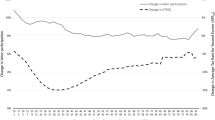Summary
On the basis of cross-section data sets for 1979 and 1987 we determine: 1) the relative contribution of changes in participation and in hours of work to the increase in married women's labor supply; 2) how much of the change in participation and hours of work is determined by changes in preferences and in budget constraints; and 3) the causes of changes in market wages and reservation wages. The increase in the average unconditional hours of work is much more due to the rise in the participation rate than to the increase in conditional hours of work. Preference changes have contributed positively to the increase in married women's labor force participation over the period 1979–1987, whereas changes in market opportunities have contributed negatively. The change in the market wage and the reservation wage can be attributed mainly to changes in the population structure of married women. Changes in the model structure contributed negatively to the change in the real market and the reservation wage. The positive effect of the change in the population structure dominates the negative effect of the model structure. Finally, participants in the labor market have a comparative wage advantage over non-participants. Non-participants are a self-selecting group with a relatively high reservation wage.
Similar content being viewed by others
References
Ashenfelter, O. and R. Layard (eds.) (1986),Handbook of Labor Economics, I, Amsterdam.
Gomulka, J. and N. Stern (1990), ‘The Employment of Married Women in the United Kingdom 1970–83,’Economica, 57, pp. 171–199.
Groot, W. and H. Pott-Buter (1991) ‘Labor Supply and Motherhood,’ Paper presented at the Fifth Annual Conference of the European Society for Population Economics, Pisa, Italy.
Hartog, J. and J. Theeuwes (1985), ‘The Emergence of the Working Wife in Holland,’Journal of Labor Economics, pp. S235–S255.
Hartog, J. and J. Theeuwes (1986), ‘Participation and Hours of Work: Two States in the Life Cycle of Married Women,’European Economic Review, 30, pp. 833–857.
Hartog, J. and J. Theeuwes (1990), ‘Arbeidseconomic,’ in: L. van der Geest (ed.),Economische theorie:: de stand van zaken, Schoonhoven.
Heckman, J. (1974), ‘Shadow Prices, Market Wages, and Labor Supply,’Econometrica, 42, pp. 679–694.
Killingsworth, M. and J. Heckman (1986), ‘Female Labor Supply, A Survey,’n: O. Ashenfelter and R. Layard (eds.),Handbook of Labor Economics, I, Amsterdam, pp. 103–104.
Kooreman, P. (1986),Essays on Microeconometric Analysis of Household Behavior PhD thesis, Tilburg University.
OECD (1988),Employment Outlook 1988, Paris.
OECD (1991),Employment Outlook 1991, Paris.
Pencavel, J. (1986), ‘Labor Supply of Men, A Survey,’ in: O. Ashenfelter and R. Layard (eds.),Handbook of Labor Economics, I, Amsterdam, pp. 3–102.
Pott-Buter, H. (1991), ‘Labor Force Participation and Fertility, A Seven Country International Comparison,’ Paper presented at the third EALE conference, Madrid.
Schama, S. (1988),The Embarrassment of Riches, An Interpretation of Dutch Culture in the Golden Age, pp. 698.
Siegers, J. (1985),Arbeidsaanbod en kindertal, PhD thesis, Rijksuniversiteit Groningen.
Theeuwes, J. (1988), ‘Arbeid en belastingen,’ in:Belastingheffing en belastinghervorming, Preadviezen van de Koninklijke Vereniging voor de Staathuishoudkunde, Leiden, pp. 111–143.
Wales, T. and J. Woodland (1980), ‘Sample Selectivity and the Estimation of Labor Supply Functions,’International Economic Review, 21, pp. 437–468.
Woittiez, I. (1991),Modelling and Empirical Evaluation of Labour Supply Behaviour, Berlin.
Author information
Authors and Affiliations
Additional information
We like to thank Joop Hartog, Jules Theeuwes, Isolde Woittiez and two anonymous referees for their comments on a previous draft of this paper.
Rights and permissions
About this article
Cite this article
Groot, W., Pott-Buter, H. Why married women's labor supply in the Netherlands has increased. De Economist 141, 238–255 (1993). https://doi.org/10.1007/BF01717382
Issue Date:
DOI: https://doi.org/10.1007/BF01717382




